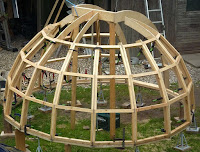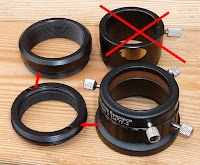*
 Friday and a bank holiday. I glued all the vertical struts to the
ribs using outdoor white wood glue. I have been very hesitant to use glue
until the structure is proven to fit together.
Friday and a bank holiday. I glued all the vertical struts to the
ribs using outdoor white wood glue. I have been very hesitant to use glue
until the structure is proven to fit together.Saturday: Re-leveled the base ring and rebuilt the dome. This time with the observation slit nearest the shed door. Hopefully this will save me having to walk right around the dome just to get inside. Now I have reached this point I ought to lower the base ring. It really doesn't have to be this high. I still don't have enough clamps.
 Sunday:
As I had reversed the dome on the base ring I thought I'd better re-check
the geometry. So I ran a long cord back and forth between each pair of
ribs to find the dome's exact center. Having planted a central pipe, as a marker, I dropped a
plumbline [just visible in the image on a red cord] from the center of the top slit beam. This proved that I had
serious level problems. So I ran a heavier rope up to the octagon fence to pull the
slit frame upright and level at the top. A diagonal, internal, timber prop would only have got in the way.
Sunday:
As I had reversed the dome on the base ring I thought I'd better re-check
the geometry. So I ran a long cord back and forth between each pair of
ribs to find the dome's exact center. Having planted a central pipe, as a marker, I dropped a
plumbline [just visible in the image on a red cord] from the center of the top slit beam. This proved that I had
serious level problems. So I ran a heavier rope up to the octagon fence to pull the
slit frame upright and level at the top. A diagonal, internal, timber prop would only have got in the way.Later I went round checking the distance to the central pipe from the inner curve of the base ring. The pipe was about 1.5" off center. I need to find a sturdier steel pipe which I can drive more firmly into the ground at dead center.
With the slit's top cross beam still too high I decided to lower the entire dome on its stands. This would hopefully make it much easier to get in and out. There followed an hour going round and round screwing down the metal jacks and adjusting the timber props. Finally I had the base ring level and almost as low as it will go on the stand screws.
The slit clearance at the zenith was now a miserable 2.5" according to the plumbline. For some reason the slit frame does not want to tip inwards and downwards to increase the clearance beyond the zenith. I presume it must be the two attached gores holding the slit frame upright. I tried pushing the base beam inwards but that didn't help either. I even double checked that the opposing central gore was not resisting my efforts. I shall now have to try unscrewing the horizontal struts on either side of the slit frame.
As can be seen from the overhead view I eventually managed to sink the slit frame slightly but not to increase the clearance at the zenith. I also added another 2x6 on a 2x8 base, timber prop. To help reduce the risk of the completed dome becoming unstable on its stands in high winds.
 The image [right] shows how sturdy the dome now appears. I think I will move the taller gores away from the slit. In their present position they offer almost no support to the unnextended gores. So the whole dome is sagging inwards at the top. Which leaves small but visible gaps between the ribs.
The image [right] shows how sturdy the dome now appears. I think I will move the taller gores away from the slit. In their present position they offer almost no support to the unnextended gores. So the whole dome is sagging inwards at the top. Which leaves small but visible gaps between the ribs.If only I had a lot more C-clamps I could close the gaps to lift the gores to their correct form and position. Fifteen times even small gaps soon adds up. Which distorts the overall shape of the dome. The plywood isn't thick enough for wood screws to bring the ribs tightly together.
The dome seems to have assumed a slightly different shape since I fitted the heavy, observing slit frame. My intention is to make the dome symmetrical and then refit the slit frame. Symmetry is important to sizing the trapezoid, covering panels.
I am quite tempted to buy a lot of nuts, washers and bolts to hold the gores more tightly together. This would be far cheaper than buying a lot more clamps. The bolts could be passed through the plywood ribs just inside the vertical struts to exert maximum pressure where it really matters. Even at three clamps per rib the spring clamps don't have the power to pull the dome really tightly together.
 I'd need about 60 nuts and bolts and 120 oversized, load spreading washers. I have now placed an order for 100 M6x30mm, A4 stainless steel, hex socket head screws, oversized 18mm [3/4"] washers and matching nuts. I tested one 6mm coach bolt and 14mm washers and seemed not to pull themselves into the birch plywood. 18mm washers will further reduce any such risk.
I'd need about 60 nuts and bolts and 120 oversized, load spreading washers. I have now placed an order for 100 M6x30mm, A4 stainless steel, hex socket head screws, oversized 18mm [3/4"] washers and matching nuts. I tested one 6mm coach bolt and 14mm washers and seemed not to pull themselves into the birch plywood. 18mm washers will further reduce any such risk.Wednesday: Drilled the ribs and fitted the nuts, washers and screws to hold the dome together. Four screws per rib = 14 x 4 = 56. So I have nearly half left to add more screws if desired. The dome is now completely self-supporting without any clamps at all. It just needs the slit frame to find its natural place with some clearance at the zenith. That will require the opposing gore ribs to be carefully trimmed back. Then I can add all the other rib extensions to secure the slit frame properly.
It is interesting how the strut dimensions dictate the shape of the dome. It cannot adopt any other shape because the dome refuses to be distorted. Raising a ring of horizontal struts would produce another shape unless they were each shortened to match their new place. If the struts were lowered on the dome's surface they would become too short for that latitude. Causing distortion and quite possibly refusing to come together at the ribs.
I wish I had been more aware of this when starting out. I would have concentrated far more on achieving perfect uniformity of strut length. I was relying on the curvature of the ribs and fitting struts to match their actual spacing. The ribs certainly helped as a guide but they were too flexible and could distort sideways if a strut was not the perfect length. Adding the vertical struts last fixed the latitude of the horizontal struts.
Click on any image for an enlargement
*










































